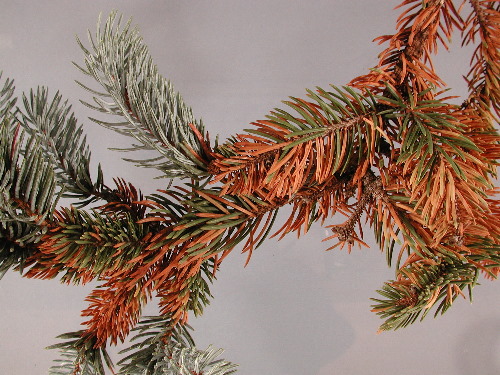This is the tenth part of a series on winter tree diseases and disorders. This article examines rhizosphaera needle cast and swiss needle cast.
Introduction
During the winter months, many of the fungal pathogens that affect trees enter dormancy. The pathogens overwinter on their hosts or in the soil, awaiting spring’s arrival. Despite the frigid temperatures, trees suffering from fungal diseases may still exhibit infection symptoms in winter, especially if the disease has advanced into its later stages. The following describes some of the most common diseases to overwinter on trees, and how they may be detected.
Rhizosphaera Needle Cast
Rhizosphaera needle cast is a fungal disease that affects many spruce trees, particularly Colorado blue spruce, and Engelmann spruce. The causal agent of the disease is the fungus, Rhizosphaera kalkhoffi. Infected spruce trees can suffer from extensive foliar dieback. Repeated defoliation can result in plant mortality.
Hosts
Colorado blue spruce, and Engelmann spruce are highly susceptible to infection. Infections also occur on white spruce and Douglas-fir, albeit with less frequency. Norway spruce exhibits relative resistance to the disease. As such, it is rarely infected. Trees that are undergoing environmental stress, or are infested with insects are more prone to infection. Young trees, and saplings are most vulnerable to infection, though trees of all ages may be invaded by the pathogen.
Symptoms of Infection
Infected spruce trees will only retain a single year of growth. Foliage on the inner branches, and on the lower portion of the crown is most susceptible to infection. When infections are severe, the lower branches will die back, and the disease will progress to the upper branches. In summer, the infected needles turn yellow. By fall, they deepen to reddish brown or purple. Trees that are sparse on the lower part of the crown, or only display a year or two of needle growth may be infected. The needles of symptomatic trees should be examined in early spring, prior to bud break. Black fruiting bodies may be observed in neat lines, along the length of the infected needles. Branches that are defoliated for three to four years will die back. This can cause the tree to develop a malformed appearance, reducing its ornamental value.
Management
- Plant spruce trees in locations that feature good drainage.
- When planting, select resistant varieties of spruce. Norway spruce, Black Hills spruce, and white spruce all exhibit an increased resistance to the disease pathogen. Trees that are grown from healthy nursing stock are ideal for planting. Avoid planting young spruce trees near older spruce trees that may be harboring the disease pathogen. Ensure that plants are afforded sufficient space to allow for proper air circulation.
- To limit the number of potential inoculum sites, eliminate weeds by periodically mowing the grass.
- Rake, and dispose of fallen needles to further reduce potential inoculum sites.
- Fungicide applications are effective at combating the disease. Initial applications should be performed when new shoots are ¾ of an inch to 1 ¼ inches long. Moderate to severe infections may require two additional applications at three week intervals.
- Maintain tree vigor through sound cultural practices. Ensure that trees are sufficiently watered, especially during extended periods of drought. Apply a layer of organic mulch around the base to improve soil quality, moderate soil temperature, and maintain soil moisture.
Swiss Needle Cast
Swiss needle cast is an important fungal disease of Douglas-fir. It is one of the most common diseases to afflict Douglas-fir, alongside Rhabdocline needle cast. Swiss needle cast infections are caused by the pathogen Phaeocryptopus gauemannii. The fungus is indigenous to the historic range of Douglas-fir in western North America. Swiss needle cast infects Douglas-fir needles. When this occurs, infected Douglas-firs suffer from at least a partial defoliation. Successive defoliations can cause infected trees to decline, inhibiting the development of healthy plant growth. Douglas-firs that are infected by Swiss needle cast often assume a gnarled or malformed appearance.
Hosts
Swiss needle cast targets Douglas-fir. Rocky Mountain varieties are especially prone to infection.
Symptoms of Infection
Symptoms of Swiss needle cast infection become apparent within 2 to 3 years. Diseased needles become discolored, brightening to yellow-green or yellow. This is followed by a browning of the needles, which begins at the tips and proceeds inward. Needle that have browned may drop prematurely. The black fruiting bodies appear as two tiny bands of structures arising on the underside of chlorotic or brown needles. The fruiting bodies can be observed throughout the year using a hand lens. The fruiting bodies measure about 0.1 mm in diameter. Swiss needle cast is often found on Douglas-firs infected with Rhabdocline needle cast.
Management
- Monitor for the appearance of the fruiting bodies in late winter. If the fruiting bodies are present, promptly remove the diseased branch or shoot. Disinfect pruning equipment in between each cut, using a solution composed of nine parts water and one part bleach. Thoroughly dry equipment thereafter to prevent rusting.
- Fungicidal applications can prevent infections from occurring, particularly on small to medium-sized Douglas-firs. Initial applications should be performed in spring, when shoots begin to expand. Administer a second application 2 to 3 weeks later. If rainfall is abundant, additional applications may be necessary to achieve sufficient control.
- When planting, select disease-resistant varieties. Douglas-fir seed originating from the Pacific Coast appears to exhibit a mild to moderate resistance to Swiss needle cast. Plant Douglas-firs in well-drained, moist soil. Provide adequate spacing between plants to promote healthy growth. Avoid planting near forests or on slopes.
- Cull severely infected Douglas-firs to reduce sources of inoculum.
- Maintain tree vigor through sound cultural practices. Ensure that trees are thoroughly watered, especially during extended periods of drought.
- In spring and fall, apply a layer of organic mulch around the base of vulnerable plants to improve the soil conditions, and insulate the root system. Mulch should be administered in fall after trees have become dormant.
- Remove weeds from around the base of Douglas-firs.
Photo courtesy of Melodie Putnam


